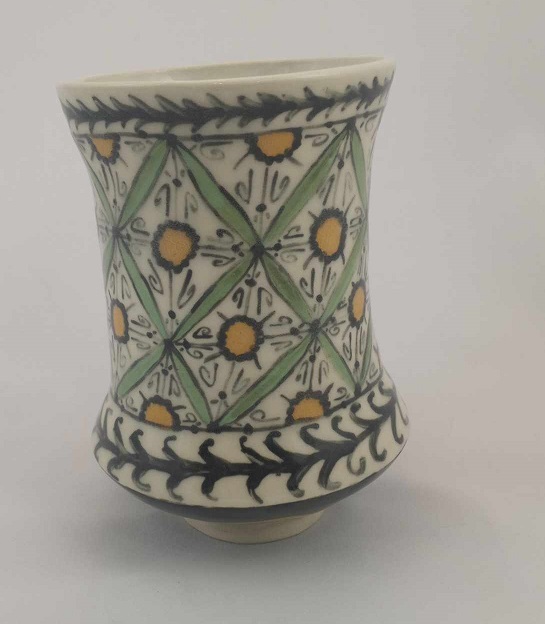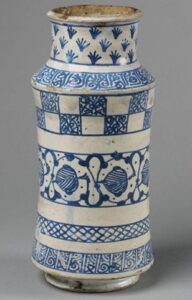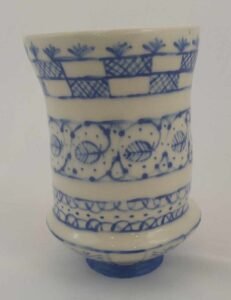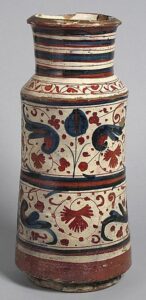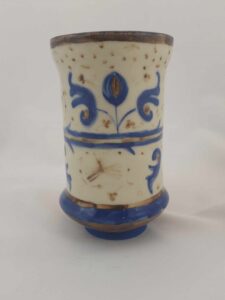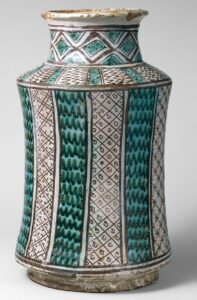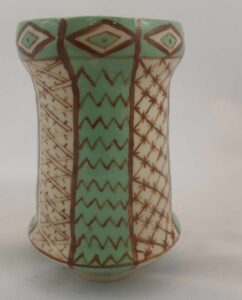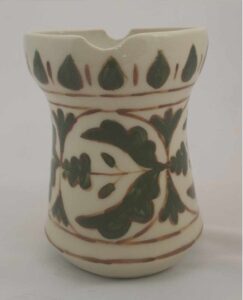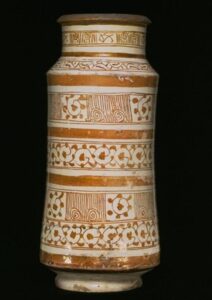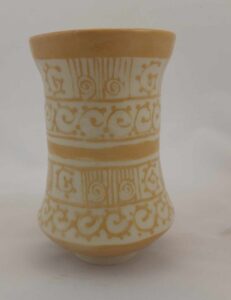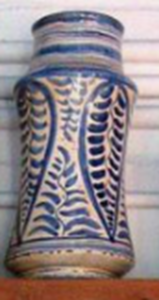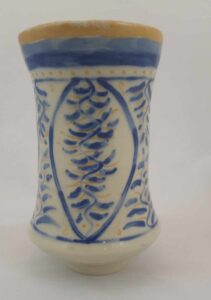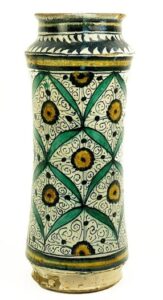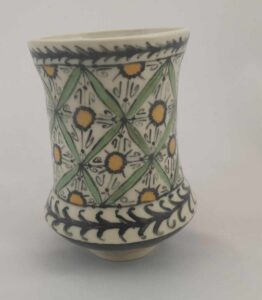Sometimes while sitting at home I find myself exploring far away places and times through the ever expanding online museum collections. While I may not be able to visit many of them in real life these online images, articles, and even books give me a window into so many lovely items. They allow me to forget about the ever increasing number of emails in my inbox and the to do list that feels like the mythic horn of plenty unable to ever come to an end.
Some background information
While studying late period Hispano-Moresque and early Italian Majolica pottery design styles I came across these jar looking objects at various museum sites that had a similar shape and size. The shapes were similar but they seemed to serve as a canvas to express a wide variety of images. Further digging resulted in the discovery they are called Albarello vessels (also known as Pharmacy or Apothecary jars).
The Albarelli (plural Albarello) are storage vessels created as a non-porous to contain solid or Viscous medicinal substances. The nature of the contents formed the shape of these vessels including their wide mouth allowing materials to be added and removed easily, and an indented middle for easy handling, and a slim shape allowing multiple storage containers to be placed on a shelf at once[1].
The origins of these vessels can be found throughout the Islamic world including Syria, Egypt, other parts of the Islamic world with the earliest known examples from Amul, Persia (Iran) created during the 11th century. The Arabian Nights story even describes what could be these jars referring to a pharmacist having a shelves with Persian ceramics.[2] By the thirteenth century these jars had made their way into Italy and were being produced in Europe by the 15th century[3].
As Albarello vessels became more prevalent in Europe their decorative techniques were influenced by the various cultures living along the Mediterranean Hispano-Moresque, Iznik, and Italian Majolica themes can be found on various pieces.
No half measures
I have several long term projects which I plan on completing in 2025 which require specifically thrown shapes and painting in Hispano-Moresque and Iznik styles. To this end I am always looking for excuses to practice both the art forms and form specific throwing on the wheel. Since I don’t apparently know how to do items in half measure and there was an art competition coming up for one of the local Society for Creative Anachronism (SCA) groups in Yakima Washington I approached this project as a chance to try throwing, drawing, and painting.
I spent several weeks looking at various museum and even Pinterest pages for inspiration till I had a large source of extant pieces to pull from. Now came the hardest part, choosing which ones. Friends and family were all asked which pieces they liked the best from my idea board (the competition would be judged by those likely not familiar with the art form so I wanted all the opinions).
While narrowing down the pieces was difficult eventually a diverse group were chosen, representing both Hispano-Moresque and Majolica design styles. It had been awhile since I had thrown and the creation of a specific shape and size eluded me. I was able to get a standard to me form, but it didn’t match the common Albarello jars. I am going to work on the shape going forward, but I had fun with this project and will defiantly be making more of them.
Below are the extant piece (on the left) and my pieces (on the right).
Hispano-Moresque Pieces
Was a form of Tin-glazed pottery which developed in the Andalusia region. The elaborate motifs incorporated geometric, plant, stylized Arabic, and floral motifs flourished in the arts during the Almohad dynasty (1150 to 1269 c.e). These motifs would continue to the Nasrid period (1232 to 1492) and beyond. This style of ceramics, also known as Nasrid, Malaga, and other various names, varied from many other techniques of ceramic decoration at the time mainly in its use of lusters and increased color pallet[4].
The motifs in this style are my favorite, and I sampled heavily from them for my pieces
The first piece is based upon a vessel at the Victoria Albert Museum. It was made in Paterna or Manises Spain about 1400. As my jar was shorter and a slightly different shape then the original I used several of the patterns, but left some such as the stylized Arabic toward the neck of the original piece off.
The third piece is also based upon a vessel at the Metropolitan Museum of art. It was made in Spain during the early 15th century. This is one of my favorite pattern which I have now sampled on several other vessels including brush jars, and cups.
Italian Majolica Pieces
During the 14th century ceramic pieces with various hand drawn elements became the fashion as the Majolica decorative form grew. Majolica decoration is completed by applying colorful pigments being placed over a tin-glazed surface allowing the artist to draw colored designs on the now white canvas of the ceramics. Originally the range of colors available were purplish, Browns, greens, and blues, but as the popularity grew by the 16th century there was a full range of colors and metallic lusters available giving the artists a true painters pallet and paintings could be found on all forms of ceramics[5].
The fourth piece was based on an auction item. While the exact place/time of this piece is unknown it matches other forms attributed to Florence during the 15th century. As is often the case with green ware and transportation, a piece broke from the rim. I decided to embrace it and add another. Now I admit though it looks like an ash-try. This is another piece I will be re-creating.
The fifth piece was based on a piece at the Victoria Albert Museum made in Paterna or Manises, Spain, about 1400-50. This turned out to be the most fun piece to create and one of my favorites of the batch.
The sixth piece was based on a picture of a wall of these vessels. While this may not be an extant piece the pattern fits the style of the Italian Majolica and I just had to try and create it.
The seventh piece was based on an auction item. While the exact place/time of this piece is unknown the stylized peacock design called to me and it soon joined the collection.
Reference sources
[1] Wallis, Henry. Italian Ceramic Art: The Albarello, a Study in Early Renaissance Maiolica. 2nd ed., B. Quaritch, 1904.
[2] Griffenhagen, George B., and Bogard, Mary. History of Drug Containers and Their Labels. United States, American Institute of the History of Pharmacy, 1999. pp.5-7
[3] Drey, Rudolf E. A.. Apothecary Jars: Pharmaceutical Pottery and Porcelain in Europe and the East, 1150-1850 : with a Glossary of Terms Used in Apothecary Jar Inscriptions. United Kingdom, Faber, 1978.
[4] Dodds, Jerrilynn Denise. Al-Andalus: The Art of Islamic Spain. The Metropolitan Museum of Art, 1992.
[5] McNab, Jessie. “Maiolica in the Renaissance.” Metmuseum.org, Metmuseum.org, 1 Oct. 2002, https://www.metmuseum.org/toah/hd/maio/hd_maio.htm.
